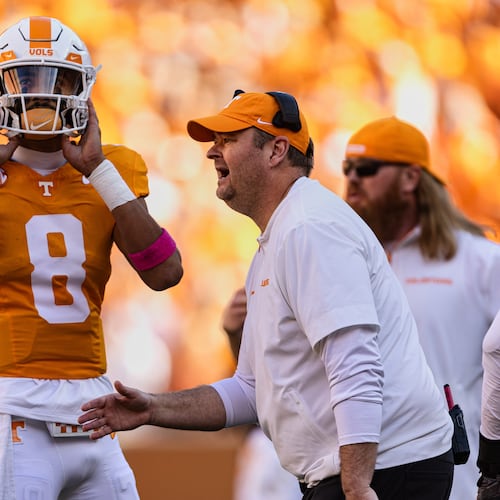Jaemyn Brakefield is in Atlanta with Ole Miss for its Sweet 16 game against Michigan State on Friday night. He’s in this column to push back on the notion that name, image and likeness payments (or, if you prefer, salaries) represent everything wrong with college athletics.
When Brakefield was in prep school in Huntington, West Virginia, the nephew of his coach often was around the team. His name was (and is) Brandon Hill. Brakefield took the boy, then 8, under his wing and remained in touch with him after he left for college.
Such was their relationship and Brakefield’s character that when he realized that Hill needed help steering clear of trouble, he jumped in. This past summer, Brakefield moved him to Oxford, Mississippi, enrolled him in high school and has served as a father figure to him.
“Obviously, I wouldn’t be able to do that without NIL,” Brakefield said Thursday.
The combination of NIL money and the transfer portal have turned college athletics upside down. It’s so easy to find a coach or administrator who calls it “the wild, wild West” that someone should probably license the phrase. Likewise, fans who want college football and basketball to go back to the way they used to be are not in short supply.
But you know who’s OK with the way it is now? The ones whom the whole industry is predicated on. The young people who coaches like to say motivated them to get into the business, to change their lives for the better.
A sampling of what I heard at Thursday’s media availability at State Farm Arena from athletes from Ole Miss, Michigan and Auburn before Friday’s South Regional semifinals indicated that NIL money was doing exactly that.
Said Ole Miss guard Davon Barnes in an interview with The AJC: “I think it’s definitely beneficial for the long run.”
Barnes said he uses some of his money to support charities in his hometown of Memphis, Tennessee, and to help provide for his family.
“I feel like with the rise of NIL, it’s given players the ability to be able to profit off their name, image and likeness, kind of like how the universities have,” Michigan guard Roddy Gayle Jr. told The AJC.
Gayle said that NIL money has allowed him to pay for trips for his parents to watch him play, and it also has helped him be more responsible as he represents himself as a brand.
“NIL money means a lot, especially for me,” Auburn forward Ja’Heim Hudson, a Wheeler High grad, told The AJC. “I come from a poorer background, not the best background. So us having this opportunity to provide for our families and provide for ourselves and build a better life for ourselves, I feel like it’s amazing.”
Hudson said he helps with his extended family’s financial needs and is invested with a partner in real estate wholesaling. None of it would be possible without NIL money.
“I’ve got a baby girl on the way,” he said. “I’m setting her up for life.”
What’s the argument against this?
College athletes making hundreds of thousands of dollars that are basically salaries isn’t what NIL was supposed to be. It was supposed to be football players getting free meals for endorsing the local pizzeria.
Yes, it was. But this is what the market has borne. It turned out that boosters, through collectives, were willing to pay athletes way, way more than that, as in millions of dollars. Are basketball players supposed to say, “No, thanks, that’s not what NIL is supposed to be. Please just give that extra money to my coach or build something like a practice facility with shiatsu machines that also rebound your shots and make protein shakes”?
The money that college athletes are making is not good for them.
When high school baseball players receive multimillion signing bonuses, do we make the same complaint?
It is undoubtedly not the norm and guidance often is needed. But if their biggest earning potential comes early in life, shouldn’t they take advantage of it? There’s no guarantee they can make that money in professional leagues.
NIL and the transfer portal are ruining college athletics by allowing athletes to change schools for better opportunities and more money. What happened to loyalty and playing for school pride?
Maybe we need to first ask that of coaches, who as a group have shown no problem with jumping ship when they can move up the ladder for a bigger job and paycheck.
Also, the first two rounds of the NCAA Tournament averaged the highest viewing audience for the first week since 1993, according to Nielsen. College football is having such a hard time drawing fans that it expanded its playoff.
All the disenchanted fans sure have a funny way of making their voices heard.
Obviously, the system at present has flaws. Non-revenue sports are feeling the pinch. Fans are paying more for tickets as schools raise prices to cover mounting costs. The SEC and Big Ten are moving away from the rest of Division I. And while seeking a bigger payout is the American way, maybe transferring three times in a career ultimately isn’t the best idea.
Even Gayle, the Michigan guard, said that, while NIL has enabled athletes to financially profit from their college careers, “I do think that NIL is kind of spiraling out of control in a sense.”
The most obvious solution to gain stability remains collective bargaining. But, in the meantime, if we really do care about the college athletes we cheer for, we ought to applaud them for they’re getting the money they’re due.
A young man in Oxford named Brandon Hill certainly is.
“It’s great,” said Brakefield, Hill’s guardian angel, said of NIL. “Obviously, it changes lives.”
About the Author
Keep Reading
The Latest
Featured

